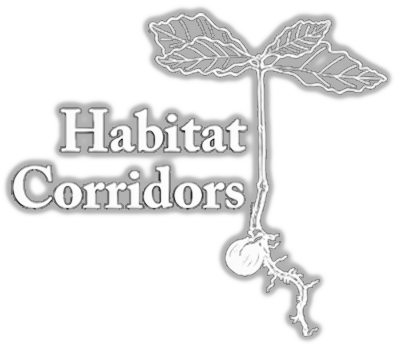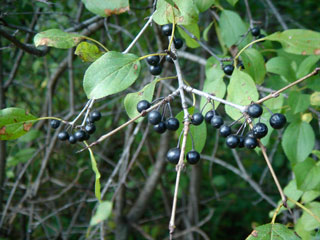Saving living space for living
things one yard at a time
This Winter Get After Buckthorn
This fall you may have noticed that as the leaves turned and our Barrington area was bursting with autumn color, there were many shrubs and small trees holding tight to their dark green, shiny leaves. Eventually the oval leaves may have turned yellow or perhaps the green leaves just fell off when the temperature dropped below freezing. This is an easy way to recognize this end-of-season dawdler, the invasive common buckthorn Rhamnus cathartica.
Buckthorn is a deciduous shrub or small tree most often found at woodland edges; and, sadly, it often exists as privacy hedges between properties or along the roads in the Barrington area. Because it tolerates any soil, has a long growing season and is so aggressive, it quickly chokes out native trees, shrubs, wildflowers and grasses. Add to that its prolific seed production, and you have a major invasive problem. The sooner you act to remove buckthorn, the better.
The best time to strike is when the plants are seedlings, and you can pull them out by hand with ease, removing roots and all. Once the plant has grown large, you will need additional tools. One excellent option is to pull as many trees as possible and then cut the remaining woody stems to the ground. Once they are cut, immediately paint the cut stumps with glyphosate (the active ingredient in Roundup®) to prevent resprouting.
Once you have treated all the stumps, carefully place thick layers of newspaper over the entire area and weight it with heavy stones or mulch. The newspapers will slowly decompose during the winter and help smother any new growth. Leaving the soil bare just invites other weeds and invasive species like garlic mustard to germinate. Instead this simple process creates a healthy spot for planting native species in the spring.
While removing buckthorn can feel overwhelming, it’s worth the effort. Buckthorn smothers our beautiful native habitat, killing everything. Since it changes the soil chemically as well as shading native species, it is extremely destructive. Our tender native plants need your help to find sunlight again! Please download this flyer for more information about removing buckthorn.

